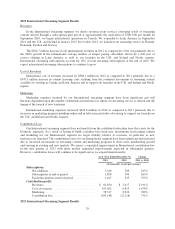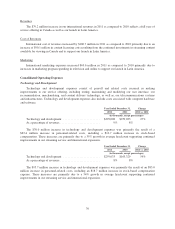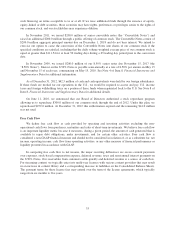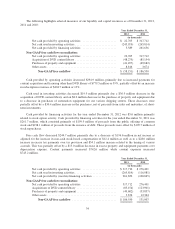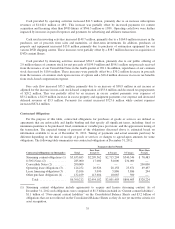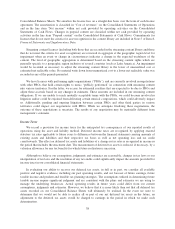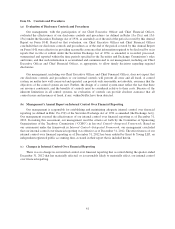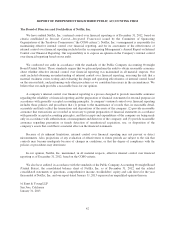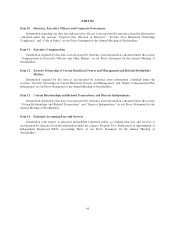NetFlix 2012 Annual Report Download - page 42
Download and view the complete annual report
Please find page 42 of the 2012 NetFlix annual report below. You can navigate through the pages in the report by either clicking on the pages listed below, or by using the keyword search tool below to find specific information within the annual report.Consolidated Balance Sheets. We amortize the license fees on a straight-line basis over the term of each license
agreement. The amortization is classified in “Cost of revenues” on the Consolidated Statements of Operations
and in the line item “Net income” within net cash provided by operating activities on the Consolidated
Statements of Cash Flows. Changes in prepaid content are classified within net cash provided by operating
activities in the line item “Prepaid content” on the Consolidated Statements of Cash Flows. Commitments for
licenses that do not meet the criteria for asset recognition in the content library are included in Note 5 of Item 8,
Financial Statements and Supplementary Data.
Streaming content licenses (including both those that are recorded in the streaming content library and those
that do not meet the criteria for asset recognition) are reviewed in aggregate at the geographic region level for
impairment when an event or change in circumstances indicates a change in the expected usefulness of the
content. The level of geographic aggregation is determined based on the streaming content rights which are
generally specific to a geographic region inclusive of several countries (such as Latin America). An impairment
would be recorded as necessary to adjust the streaming content library to the lower of unamortized cost or
estimated net realizable value. No material write down from unamortized cost to a lower net realizable value was
recorded in any of the periods presented.
We have licenses with performing rights organizations (“PROs”), and are currently involved in negotiations
with other PROs, that hold certain rights to music “publicly performed” in connection with streaming content
into various territories. For the latter, we accrue for estimated royalties that are expected to be due to PROs and
adjust these accruals based on any changes in estimates. These amounts are included in our streaming content
obligations. If we are unable to reach mutually acceptable terms with the PROs, we could become involved in
litigation and/or could be enjoined from delivering certain musical compositions, which could adversely impact
us. Additionally, pending and ongoing litigation between certain PROs and other third parties in various
territories could impact our negotiations with PROs. While we anticipate finalizing these negotiations, the
outcome of these negotiations is uncertain. The results of any negotiation may be materially different from
management’s estimates.
Income Taxes
We record a provision for income taxes for the anticipated tax consequences of our reported results of
operations using the asset and liability method. Deferred income taxes are recognized by applying enacted
statutory tax rates applicable to future years to differences between the financial statement carrying amounts of
existing assets and liabilities and their respective tax bases as well as net operating loss and tax credit
carryforwards. The effect on deferred tax assets and liabilities of a change in tax rates is recognized in income in
the period that includes the enactment date. The measurement of deferred tax assets is reduced, if necessary, by a
valuation allowance for any tax benefits for which future realization is uncertain.
Although we believe our assumptions, judgments and estimates are reasonable, changes in tax laws or our
interpretation of tax laws and the resolution of any tax audits could significantly impact the amounts provided for
income taxes in our consolidated financial statements.
In evaluating our ability to recover our deferred tax assets, in full or in part, we consider all available
positive and negative evidence, including our past operating results, and our forecast of future earnings, future
taxable income and prudent and feasible tax planning strategies. The assumptions utilized in determining future
taxable income require significant judgment and are consistent with the plans and estimates we are using to
manage the underlying businesses. Actual operating results in future years could differ from our current
assumptions, judgments and estimates. However, we believe that it is more likely than not that all deferred tax
assets recorded on our Consolidated Balance Sheets will ultimately be realized. In the event we were to
determine that we would not be able to realize all or part of our net deferred tax assets in the future, an
adjustment to the deferred tax assets would be charged to earnings in the period in which we make such
determination.
38



